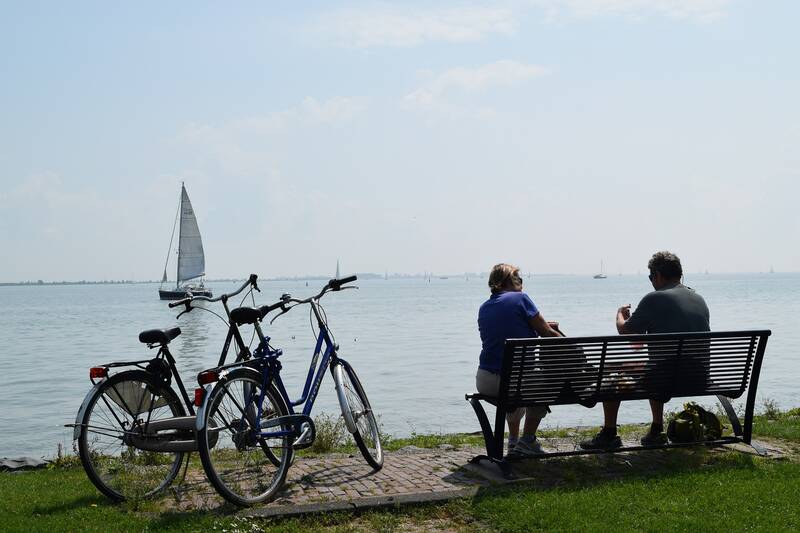Shinrin-Yoku: Forest Bathing For Health

Navigating our modern lives
With emerging technology, humans have been lured further and further from nature. In fact, it’s estimated by the United States Environmental Protection Agency that we spend roughly 90 percent of our time indoors. [1]
Our artificial environments consist of artificial blue light, industrial air pollution, noise pollution, and concrete. It’s no surprise that this move towards technology has come with consequences. The following health conditions are found at a higher rate among urbanites:
- Anxiety [2]
- Depression [3]
- Mood disorders [2]
- PTSD [4]
- Schizophrenia [5]
- Cardiovascular diseases [6]
- Respiratory diseases [7]
- Diabetes [8]
- Obesity [9]
- Insulin resistance [9]
- Cancer [10]
To mitigate the effects of our lifestyle, we're typically given treatments from modern medicine.
But what if there was a natural route to relief? The therapeutic benefits of shinrin-yoku, AKA forest bathing, have caught our attention.
A brief history of forest bathing
In the 1980s, the people of Japan began noting the detrimental effects of stressors in their modern lives. This led many people to follow their intuition back into nature. Many could finally alleviate their long-suffered conditions.
The Director of the Japanese Forestry Agency coined the name “shinrin-yoku” for this medicinal practice, a term translating to “forest bath” or “taking in the forest atmosphere.” This began the suggestion of exposure to forests for healing purposes.
Who would have known that by simply immersing ourselves in nature, we can mitigate the effects of our modern lives? Therapeutic benefits felt by the people of Japan were later studied and confirmed to be quite significant.
Many of the lifestyle diseases improved through forest bathing include:
- Hypertension [11]
- Anxiety [12]
- High cortisol [13]
- Depression [14]
- Cancers [15]
- Cardiovascular diseases [11]
- Inflammation [16]
- Asthma [17]
- Atopic dermatitis [18]
- Chronic obstructive pulmonary disease [19]
- Chronic pain [20]
- Cognitive decline/dysfunction [21]
- Diabetes [22]
- Hyperglycemia [22]
- Oxidative stress [23]
- Poor sleep quality [24]
How forest bathing counteracts stress
Humans share a natural inclination to be in nature, as it's fundamental to our biology. An initial benefit felt when returning to nature is the drastic stress relief. Salivary cortisol concentration is the gold standard for biomarkers in stress research. [25] This biomarker has lowered significantly with forest-based intervention. [13]
There's an interesting combined effect of walking and forest-based environmental observation. This has influenced research on the benefits of walking in natural environments. This brought about thirteen studies published from 1991 to 2008. Nature therapy reduces negative emotions such as stress, anger, fatigue, and depression, while increasing feelings of energy. [26]
There is an undeniable relaxation effect brought on by forest settings. This phenomenon improves many physiological stress biomarkers – such as salivary cortisol concentration, pulse rate, blood pressure, and heart rate variability. Changes reveal the physiological and psychological benefits of decreased hypertension, [11] anxiety, [12] cortisol levels, [13] depression, [14] and poor sleep. [27] It’s no surprise that our modern lives have such detrimental effects on our well-being.
Our biology craves the well-documented benefits of forest bathing brought on by submerging our senses into nature. We prize sunlight, fresh air, and the natural ground beneath our feet for their healing components. We can experience these benefits of forest bathing in any natural environment. Whether in the forests or our backyards, our mind and body are able to recover from modern stressors.
Forest air enhances our innate immunity
When we look to improve our immunity, we generally point towards our diet. While nutrition plays a major role, studies show that our environment does as well. This brings us to the medicinal properties of phytoncides, better known as tree essential oils. [28]

Trips to the forest can boost immune cells that eliminate tumors, microbial infections, and tissue damage. [28] We call these immune cells human natural killer (NK) cells. [29] The mechanism responsible for this biological enhancement is the tree’s natural phytoncides. Phytoncides can enhance our NK cell activity. [30]
Some recognized phytoncides include: α-pinene, d-limonene, β-pinene, sabinene, myrcene, and camphene. These all come from various tree species. The enhancement of NK cell activity after only 2 hours spent in the forest can last for days. [28]
More benefits of inhaling phytoncides include mood enhancement, [31] reduced inflammation, [32] reduced oxidative stress, [33] and reduced blood glucose levels. [22]
There is no better aromatherapy than the one brought to us by nature!
Experiencing the benefits of forest bathing anywhere
For many of us, the nearest forests are miles away. But are the benefits bound to this distance?
Luckily, we are never too far away to experience the benefits of forest bathing. Tapping into our innate biology can be done with just a square foot of natural earth for ground contact. [34] Our innate healing mechanisms are influenced by sunbathing, [35] breathing, [36] and listening to the many sounds of nature. [37]
Without a doubt, forest bathing can replace many common medical interventions. By limiting our sedentary habits, [38] screen time, [39] and our exposure to technology, [40] we can preserve our natural ability to thrive.
It's common to suppress symptoms caused by artificial environments with artificial treatments, but this is a step in the wrong direction. Covering up our body’s cry for nature is only leading to amplified effects. Stepping outside is how we distance ourselves from our rapidly digitalizing world. Despite groundbreaking advances in medicine, nature is always two steps ahead in meeting our needs.

Takeaway tips
- With every opportunity, take your lunch, workouts, and free time outside. [41]
- Locate your favorite natural area – trails, forests, beaches, or even Certified Forest Therapy Trails.
- Dress in non-restrictive, comfortable clothing. [42] [43]
- Immerse your senses in nature. This includes taking in the noises, smells, and scenes. [44]
- Allow your mind to be at ease with nature. Replace any racing thoughts with a new focus on your surroundings. Slow down your breath and note this feeling. [45]
- Once back in your modern environment, seek the innate, meditative state you found within yourself. [46]
References
- U.S. Environmental Protection Agency. 1989. Report to Congress on indoor air quality: Volume 2. EPA/400/1-89/001C. Washington, DC.
- Peen J, Schoevers RA, Beekman AT, Dekker J. The current status of urban-rural differences in psychiatric disorders. Acta Psychiatr Scand. 2010 Feb;121(2):84-93. doi: 10.1111/j.1600-0447.2009.01438.x.
- Agid O, Kohn Y, Lerer B. Environmental stress and psychiatric illness. Biomed Pharmacother. 2000 Apr;54(3):135-41. doi: 10.1016/S0753-3322(00)89046-0.
- Bielinis E, Jaroszewska A, Łukowski A, Takayama N. The Effects of a Forest Therapy Programme on Mental Hospital Patients with Affective and Psychotic Disorders. Int J Environ Res Public Health. 2019 Dec 23;17(1):118. doi: 10.3390/ijerph17010118. PMID: 31877954; PMCID: PMC6982075.
- Gruebner O, Rapp MA, Adli M, Kluge U, Galea S, Heinz A. Cities and Mental Health. Dtsch Arztebl Int. 2017 Feb 24;114(8):121-127. doi: 10.3238/arztebl.2017.0121.
- Münzel T, Herzog J, Schmidt FP, Sørensen M. Environmental stressors and cardiovascular disease: the evidence is growing. Eur Heart J. 2017 Aug 1;38(29):2297-2299. doi: 10.1093/eurheartj/ehx306.
- Galea S, Vlahov D. Urban health: evidence, challenges, and directions. Annu Rev Public Health. 2005;26:341-65. doi: 10.1146/annurev.publhealth.26.021304.144708.
- Saeedi P, Petersohn I, Salpea P, Malanda B, Karuranga S, Unwin N, Colagiuri S, Guariguata L, Motala AA, Ogurtsova K, Shaw JE, Bright D, Williams R; IDF Diabetes Atlas Committee. Global and regional diabetes prevalence estimates for 2019 and projections for 2030 and 2045: Results from the International Diabetes Federation Diabetes Atlas, 9th edition. Diabetes Res Clin Pract. 2019 Nov;157:107843. doi: 10.1016/j.diabres.2019.107843.
- Eze IC, Schaffner E, Foraster M, Imboden M, von Eckardstein A, Gerbase MW, Rothe T, Rochat T, Künzli N, Schindler C, Probst-Hensch N. Long-Term Exposure to Ambient Air Pollution and Metabolic Syndrome in Adults. PLoS One. 2015 Jun 23;10(6):e0130337. doi: 10.1371/journal.pone.0130337.
- United Nations. UN Health Agency Warns of Rise in Urban Air Pollution.
- Ideno Y, Hayashi K, Abe Y, Ueda K, Iso H, Noda M, Lee JS, Suzuki S. Blood pressure-lowering effect of Shinrin-yoku (Forest bathing): a systematic review and meta-analysis. BMC Complement Altern Med. 2017 Aug 16;17(1):409. doi: 10.1186/s12906-017-1912-z.
- Farrow MR, Washburn K. A Review of Field Experiments on the Effect of Forest Bathing on Anxiety and Heart Rate Variability. Glob Adv Health Med. 2019 May 16;8:2164956119848654. doi: 10.1177/2164956119848654.
- Antonelli M, Barbieri G, Donelli D. Effects of forest bathing (shinrin-yoku) on levels of cortisol as a stress biomarker: a systematic review and meta-analysis. Int J Biometeorol. 2019 Aug;63(8):1117-1134. doi: 10.1007/s00484-019-01717-x.
- Kotera, Y., Richardson, M. & Sheffield, D. Effects of Shinrin-Yoku (Forest Bathing) and Nature Therapy on Mental Health: a Systematic Review and Meta-analysis. Int J Ment Health Addiction 20, 337–361 (2022). https://doi.org/10.1007/s11469-020-00363-4
- Putra, Ricky & Veridianti, Dominika & Nathalia, Evelyn & Brilliant, Danny & Rosellinny, Graciella & Suarez, Cristina & Sumarpo, Anton. (2018). Immunostimulant Effect from Phytoncide of Forest Bathing to Prevent the Development of Cancer. Advanced Science Letters. 24. 6653-6659. 10.1166/asl.2018.12804.
- Wen Y, Yan Q, Pan Y, Gu X, Liu Y. Medical empirical research on forest bathing (Shinrin-yoku): a systematic review. Environ Health Prev Med. 2019 Dec 1;24(1):70. doi: 10.1186/s12199-019-0822-8.
- Edwards A, Woods V. Forest-based Therapy: Research Letter of a Novel Regime for Improved Respiratory Health. Integr Med (Encinitas).
- Lee, Sang Baek, et al. Combined Removal of N-Heptane and CO Using Plasma-Catalytic Process. Journal of the Korean Institute of Gas, vol. 20, no. 2, 한국가스학회, Apr. 2016, pp. 1–9, doi:10.7842/KIGAS.2016.20.2.1.
- Yau, K.KY., Loke, A.Y. Effects of forest bathing on pre-hypertensive and hypertensive adults: a review of the literature. Environ Health Prev Med 25, 23 (2020). https://doi.org/10.1186/s12199-020-00856-7
- Kang B, Kim T, Kim MJ, Lee KH, Choi S, Lee DH, Kim HR, Jun B, Park SY, Lee SJ, Park SB. Relief of Chronic Posterior Neck Pain Depending on the Type of Forest Therapy: Comparison of the Therapeutic Effect of Forest Bathing Alone Versus Forest Bathing With Exercise. Ann Rehabil Med. 2015 Dec;39(6):957-63. doi: 10.5535/arm.2015.39.6.957.
- Won Sop Shin, Chang Seob Shin, Poung Sik Yeoun & Jae Joon Kim (2011) The influence of interaction with forest on cognitive function, Scandinavian Journal of Forest Research, 26:6, 595-598, DOI: 10.1080/02827581.2011.585996
- Ohtsuka Y, Yabunaka N, Takayama S. Shinrin-yoku (forest-air bathing and walking) effectively decreases blood glucose levels in diabetic patients. Int J Biometeorol. 1998 Feb;41(3):125-7. doi: 10.1007/s004840050064. PMID: 9531856.
- Mao GX, Lan XG, Cao YB, Chen ZM, He ZH, Lv YD, Wang YZ, Hu XL, Wang GF, Yan J. Effects of short-term forest bathing on human health in a broad-leaved evergreen forest in Zhejiang Province, China. Biomed Environ Sci. 2012 Jun;25(3):317-24. doi: 10.3967/0895-3988.2012.03.010.
- Li Q, Ochiai H, Ochiai T, Takayama N, Kumeda S, Miura T, Aoyagi Y, Imai M. Effects of forest bathing (shinrin-yoku) on serotonin in serum, depressive symptoms and subjective sleep quality in middle-aged males. Environ Health Prev Med. 2022;27:44. doi: 10.1265/ehpm.22-00136.
- Hellhammer DH, Wüst S, Kudielka BM. Salivary cortisol as a biomarker in stress research. Psychoneuroendocrinology. 2009 Feb;34(2):163-171. doi: 10.1016/j.psyneuen.2008.10.026. Epub 2008 Dec 18. PMID: 19095358.
- Bowler, D.E., Buyung-Ali, L.M., Knight, T.M. et al. A systematic review of evidence for the added benefits to health of exposure to natural environments. BMC Public Health 10, 456 (2010). https://doi.org/10.1186/1471-2458-10-456
- LaVoy EC, Palmer CA, So C, Alfano CA. Bidirectional relationships between sleep and biomarkers of stress and immunity in youth. Int J Psychophysiol. 2020 Dec;158:331-339. doi: 10.1016/j.ijpsycho.2020.10.010. Epub 2020 Oct 29. PMID: 33130179.
- Li Q. Effect of forest bathing trips on human immune function. Environ Health Prev Med. 2010 Jan;15(1):9-17. doi: 10.1007/s12199-008-0068-3.
- Vivier, E., Tomasello, E., Baratin, M. et al. Functions of natural killer cells. Nat Immunol 9, 503–510 (2008). https://doi.org/10.1038/ni1582
- Li Q, Nakadai A, Matsushima H, Miyazaki Y, Krensky AM, Kawada T, Morimoto K. Phytoncides (wood essential oils) induce human natural killer cell activity. Immunopharmacol Immunotoxicol. 2006;28(2):319-33. doi: 10.1080/08923970600809439.
- Donelli D, Meneguzzo F, Antonelli M, Ardissino D, Niccoli G, Gronchi G, Baraldi R, Neri L, Zabini F. Effects of Plant-Emitted Monoterpenes on Anxiety Symptoms: A Propensity-Matched Observational Cohort Study. Int J Environ Res Public Health. 2023 Feb 4;20(4):2773. doi: 10.3390/ijerph20042773.
- Memon A, Kim BY, Kim SE, Pyao Y, Lee YG, Kang SC, Lee WK. Anti-Inflammatory Effect of Phytoncide in an Animal Model of Gastrointestinal Inflammation. Molecules. 2021 Mar 26;26(7):1895. doi: 10.3390/molecules26071895.
- Abe T, Hisama M, Tanimoto S, Shibayama H, Mihara Y, Nomura M. Antioxidant effects and antimicrobial activites of phytoncide. Biocontrol Sci. 2008 Mar;13(1):23-7. doi: 10.4265/bio.13.23. PMID: 18432113.
- Oschman JL, Chevalier G, Brown R. The effects of grounding (earthing) on inflammation, the immune response, wound healing, and prevention and treatment of chronic inflammatory and autoimmune diseases. J Inflamm Res. 2015 Mar 24;8:83-96. doi: 10.2147/JIR.S69656.
- Mead MN. Benefits of sunlight: a bright spot for human health. Environ Health Perspect. 2008 Apr;116(4):A160-7. doi: 10.1289/ehp.116-a160. Erratum in: Environ Health Perspect. 2008 May;116(5):A197.
- Ma X, Yue ZQ, Gong ZQ, Zhang H, Duan NY, Shi YT, Wei GX, Li YF. The Effect of Diaphragmatic Breathing on Attention, Negative Affect and Stress in Healthy Adults. Front Psychol. 2017 Jun 6;8:874. doi: 10.3389/fpsyg.2017.00874.
- Francis CD, Newman P, Taff BD, White C, Monz CA, Levenhagen M, Petrelli AR, Abbott LC, Newton J, Burson S, Cooper CB, Fristrup KM, McClure CJW, Mennitt D, Giamellaro M, Barber JR. Acoustic environments matter: Synergistic benefits to humans and ecological communities. J Environ Manage. 2017 Dec 1;203(Pt 1):245-254. doi: 10.1016/j.jenvman.2017.07.041.
- Phuphanich ME, Droessler J, Altman L, Eapen BC. Movement-Based Therapies in Rehabilitation. Phys Med Rehabil Clin N Am. 2020 Nov;31(4):577-591. doi: 10.1016/j.pmr.2020.07.002.
- Lissak G. Adverse physiological and psychological effects of screen time on children and adolescents: Literature review and case study. Environ Res. 2018 Jul;164:149-157. doi: 10.1016/j.envres.2018.01.015.
- Kıvrak EG, Yurt KK, Kaplan AA, Alkan I, Altun G. Effects of electromagnetic fields exposure on the antioxidant defense system. J Microsc Ultrastruct. 2017 Oct-Dec;5(4):167-176. doi: 10.1016/j.jmau.2017.07.003.
- Hunter MR, Gillespie BW, Chen SY. Urban Nature Experiences Reduce Stress in the Context of Daily Life Based on Salivary Biomarkers. Front Psychol. 2019 Apr 4;10:722. doi: 10.3389/fpsyg.2019.00722.
- MacHose, M., Peper, E. The effect of clothing on inhalation volume. Biofeedback and Self-Regulation 16, 261–265 (1991). https://doi.org/10.1007/BF01000020
- Yoo WG. Effect of wearing tight pants on the trunk flexion and pelvic tilting angles in the stand-to-sit movement and a seated posture. J Phys Ther Sci. 2016 Jan;28(1):93-5. doi: 10.1589/jpts.28.93.
- Franco LS, Shanahan DF, Fuller RA. A Review of the Benefits of Nature Experiences: More Than Meets the Eye. Int J Environ Res Public Health. 2017 Aug 1;14(8):864. doi: 10.3390/ijerph14080864.
- Zaccaro A, Piarulli A, Laurino M, Garbella E, Menicucci D, Neri B, Gemignani A. How Breath-Control Can Change Your Life: A Systematic Review on Psycho-Physiological Correlates of Slow Breathing. Front Hum Neurosci. 2018 Sep 7;12:353. doi: 10.3389/fnhum.2018.00353.
- Jo H, Song C, Miyazaki Y. Physiological Benefits of Viewing Nature: A Systematic Review of Indoor Experiments. Int J Environ Res Public Health. 2019 Nov 27;16(23):4739. doi: 10.3390/ijerph16234739.
Published 2025-06-30, by Denise Minger.